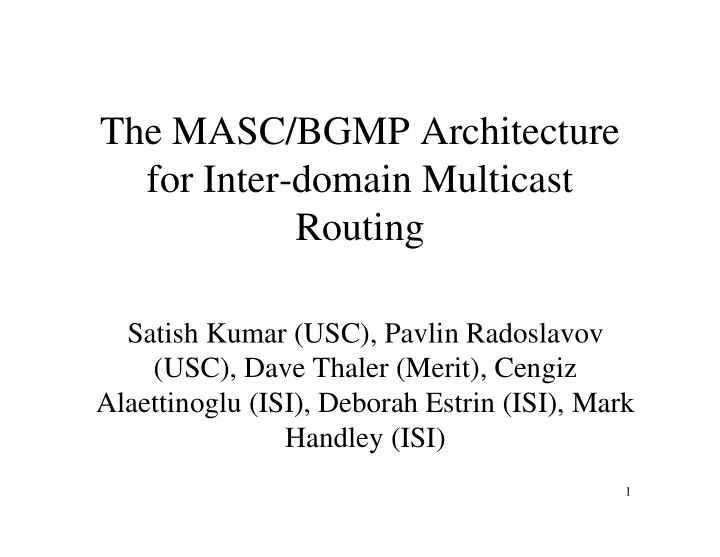

The MASC/BGMP Architecture for Inter-domain Multicast Routing Satish Kumar (USC), Pavlin Radoslavov (USC), Dave Thaler (Merit), Cengiz Alaettinoglu (ISI), Deborah Estrin (ISI), Mark Handley (ISI) 1
Current multicast situation (one big domain) does not scale • Address allocation: can collide with anyone in the world • Route distribution: exponential increase in Mbone routes • Tree construction: source-tree protocols floods data, membership; shared-tree protocols flood core lists 2
Solution: divide net into domains • Similar to solution for unicast (e.g. BGP) • Domain autonomy adds stability and enables policy control • Inside domains, can use existing mechanisms for address allocation, routing, and tree construction • Between domains, need policy control 3
Also need to minimize “third- party dependencies” such as: • Relying on PIM Rendezvous Point in someone else’s domain for general “infrastructure” groups (SDR, NTP, mtrace, etc) • Data loss over another provider’s link • Address allocation via single global authority 4
Goals • Construct group-shared trees rooted in group initiator’s domain • Use bidirectional trees to minimize third- party dependencies Root S1 S2 R R 5
Goals (cont.) • Use simple scalable mapping of group to tree root • Add topological significance to group addresses to allow state aggregatability 6
Three parts to solution • MASC associates aggregatable group- prefixes with domains • BGP distributes routes to those group prefixes (“group routes”) subject to policy • BGMP constructs bi-directional shared trees of domains 7
MASC associates aggregatable group-prefixes with domains 226.1/16 228.10/16 226.1.0/24 226.1.128/24 228.10.0/24 Allocations must be dynamic to adapt to usage patterns 8
MASC uses a claim-collide mechanism (summary) • Claimant learns parent prefix and lifetime • Claimant chooses a sub-prefix and lifetime • Claimant sends claim to parent (if any) and siblings • Claimant listens for collisions • After timeout, claimant can use prefix • Timeout based on maximum partition time 9
MASC uses a claim-collide mechanism (example) 226.1/16 226.1/16 226.1.128/24 Collision! 226.1.128/24 Collision causes loser to choose another prefix 10
Why claim-collide? • Query-response has third-party dependency at top level • Query-response with multiple servers introduces synchronization complexity • Claim-collide is same at all levels • Claim-collide appears simpler, and more robust 11
Multiprotocol BGP distributes group routes subject to policy 226.1/16 226.1.0/24 Default Default Policy is realized through selective propagation of group routes 12
BGMP constructs bi-directional shared trees Root S1 S2 R R R domain • A group’s tree is rooted at the creator’s domain (not a single router) • BGMP uses intra-domain routing inside 13
Data from sender-only domains just follows group routes 226.1/16 226.1.0/24 Default Default RD S1 Sender Root domain to 226.1.0.3 for 226.1.0/24 Forwarding occurs as in unicast 14
Joins from receiver domains also follow group routes 226.1.0/24 Default RD R S1 Root domain Receiver for 226.1.0/24 joins 226.1.0.3 15
SPT-based domains require encapsulation from group tree RD S (S,G) Join A B R DVMRP Encapsulation is avoided with source-specific branch 16
Source trees are incompatible with bidirectional (*,G) trees RD B R1 A S R2 Duplicates or black holes can form! 17
BGMP’s (S,G) branch stops at first on-tree router • Result is a “Hybrid” bidir shared tree with some unidir (S,G) branches • Hybrid tree path 20% longer than SPT • Bidir shared tree path 30% longer than SPT • Unidir shared tree path 100% longer than SPT 18
BGMP/MASC Architecture Summary • Third-party dependencies are minimized • Use of BGP allows policy control of trees • Topological significance of group addresses allows state aggregation • Source-specific branches avoid encapsulation without causing loops 19
Recommend
More recommend